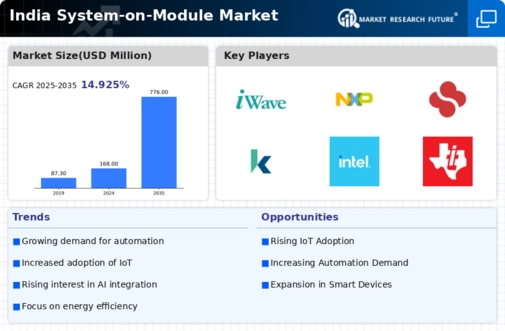Increased Investment in R&D
Investment in research and development (R&D) within the system on-module market is on the rise in India. Companies are recognizing the importance of innovation to stay competitive and meet the evolving needs of consumers. The system on-module market industry is experiencing a boost as firms allocate more resources to R&D, with an estimated increase of 30% in funding over the next few years. This focus on innovation is expected to lead to the development of advanced modules that offer enhanced performance and energy efficiency. As a result, the market is likely to witness a wave of new products that cater to diverse applications.
Rising Demand for IoT Solutions
The increasing adoption of Internet of Things (IoT) solutions in India is driving the system on-module market. As industries seek to enhance operational efficiency and connectivity, the demand for compact and integrated modules rises. The system on-module market industry is witnessing a surge, with projections indicating a growth rate of approximately 15% annually. This trend is particularly evident in sectors such as manufacturing, healthcare, and smart cities, where IoT applications are becoming integral. The need for real-time data processing and remote monitoring further propels the demand for these modules, as they offer streamlined solutions that cater to the evolving technological landscape.
Growing Focus on Miniaturization
The trend towards miniaturization in electronic devices is significantly influencing the system on-module market. As consumer preferences shift towards smaller, more efficient devices, manufacturers are compelled to innovate and develop compact solutions. The system on-module market industry is responding to this demand, with a projected growth rate of 18% as companies strive to create smaller modules without compromising performance. This trend is particularly relevant in sectors such as consumer electronics and wearables, where space constraints are paramount. The ability to integrate multiple functionalities into a single module is becoming a key differentiator in the market.
Government Initiatives and Support
Government initiatives aimed at promoting electronics manufacturing in India significantly impact the system on-module market. Programs such as Make in India and Production-Linked Incentive (PLI) schemes encourage local production and innovation. The system on-module market industry benefits from these policies, as they provide financial incentives and support for research and development. As a result, domestic manufacturers are increasingly investing in advanced technologies, leading to a more competitive market landscape. The government's focus on self-reliance in electronics is expected to bolster the market, with an anticipated growth of around 20% over the next few years.
Integration of AI and Machine Learning
The integration of artificial intelligence (AI) and machine learning (ML) technologies into system on-modules is transforming the market landscape in India. These technologies enable enhanced data processing capabilities and intelligent decision-making, which are crucial for various applications. The system on-module market industry is adapting to this trend, with an estimated increase in demand for AI-enabled modules by 25% in the coming years. Industries such as automotive, healthcare, and agriculture are leveraging these advancements to improve efficiency and reduce operational costs. This shift towards intelligent systems is likely to redefine the competitive dynamics within the market.























Leave a Comment